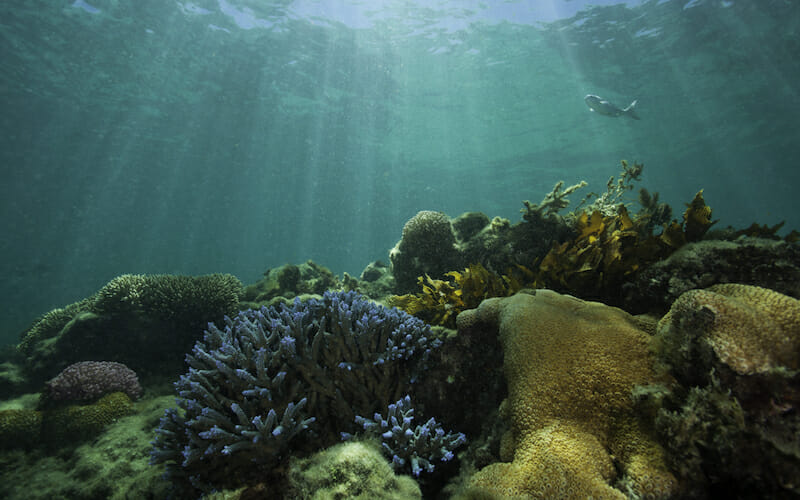
Coral’s Other Crisis: Mass Tourism
When it comes to the victims of climate change, it is hardly only the low-lying wonders like the ancient city of Venice that are set to vanish within the next few decades. According to a new report from the International Union for Conservation of Nature (IUCN), the number of UNESCO World Heritage sites, from the Great Barrier Reef to the Everglades, that run the risk of being irreparably damaged from the effects of climate change has almost doubled to 62 in the past three years alone.
Coral reefs like Australia’s are in particular jeopardy, since half of all reefs have died in the past 30 years and it is estimated that 90% will be extinct by 2050 if preventative action is not taken. Climate change is a critical causal factor in this trend, with rising water temperatures and changes in ocean pH contributing significantly to coral bleaching. New research suggests, however, that coral reefs might be more resilient to climate change than expected, with certain reefs able to adapt to moderate changes in ocean temperatures.
Whether or not the world’s reefs can eventually resist the effects of climate change, though, other factors not directly linked with global warming – such as overfishing, tourism, and pollution – continue to pose a serious threat.
In the Caribbean, for instance, experts estimate that corals have declined by more than 50% since 1970 and are threatened with extinction within 20 years. A key reason for this is overfishing, which has altered the delicate balance of the ecosystem and allowed harmful algae to flourish. But humans – many of whom, ironically, travel to the region to see its reefs in person – are also a key factor in the decline. In Belize – part of the Mesoamerican reef eco-region, the second largest barrier reef in the world – what has been called the most impressive restoration project in the Caribbean now runs the risk of seeing its gains neutralized by a host of preventable factors such as expanding hotel resorts, patchy law enforcement, and oil extraction.
Indeed, tourism is a threat to coral in numerous destinations, not only in the Caribbean. In Asia, Vietnam has tried to expand its tourist industry in recent years, touting attractions like the UNESCO World Heritage Site Halong Bay. But as the tourism industry booms, with a 28% increase in visitors so far this year compared with the same period last year, the country is struggling to strike a balance between economic development and environmental sustainability. For instance, Halong Bay is now described as an “ecological disaster” due to the toxic chemicals seeping from tourist boats. 96% of Vietnam’s coral reefs are now badly damaged by tourism and pollution and 75% face extinction, even as 20 million people depend on the ecosystem to make a living. But the question of whether the visitors have already wreaked too much damage remains.

Coral reefs are also in peril in Hawaii, where tourism accounts for a quarter of the island’s economy. According to the National Oceanic and Atmospheric Administration, 56% of the Big Island’s reefs, 44% of the coral west of Maui, and 32% of the reefs around Oahu were bleached within the past three years alone. While temperature has been the most influential factor in the bleaching, Hawaii’s status as a popular tourist destination has also played a role. In February, Hawaii senator Will Espero proposed a ban on chemical sunscreens like oxybenzone, which have been shown to play a major role in coral bleaching. According to one study, researchers found oxybenzone concentrations in some local waters more than 30 times the level considered safe for coral reefs.
For residents of places like Hawaii – and beyond – preservation of coral reefs is simply common sense. In total, an estimated 1 billion people worldwide depend on coral reefs for both food and income from fishing. Reefs also help protect lives and property on land, acting as natural barriers in the event of hurricanes and other extreme weather events. Over 70 countries around the world have so-called “million dollar reefs” that generate income of around $1 million per square kilometer, totaling close to $30 billion in total annual revenues from tourism, fisheries, coastal protection, and medicine. This is not to mention the intrinsic value of these marine wonders – which explains why so many are commemorated as World Heritage Sites.
At the very least, some solutions are emerging to help preserve the world’s coral, many of them local initiatives. In addition to the proposed ban on chemical sunscreens, Hawaii is making efforts to revamp the culture of its tourist industry, developing an ecotourism system to grade local tour operators against key criteria. Australia boasts several sustainable tourism resorts. For example, the Green Island resort around the Great Barrier Reef, is the first one to reduce its CO2 footprint to zero by offsetting its emissions through Greenfleet, who use federal government support to plant native trees. The NGO is responsible for offsetting almost 3 million tons of carbon. Sustainable tourism is also gaining traction in the Caribbean, where Philip Stephenson, the owner of the tiny island of Petit St. Vincent, has helped pioneer sustainable island resorts. His foundation, in conjunction with the non-profit CLEAR Caribbean, has started a coral restoration project which employs ‘coral gardeners’ to help manage Elkhorn coral nurseries and monitor reefs in the region.
Despite such attempts to roll back the destruction of marine ecosystems, a more concerted, multi-pronged approach will be needed to stop the reefs from being wiped completely off the list of the world’s wonders within the next century. Climate change is clearly not the only challenge: a whole host of destructive human activities must be combatted to save these marvels before it is too late.

